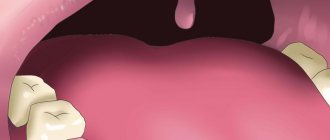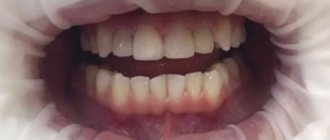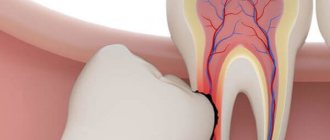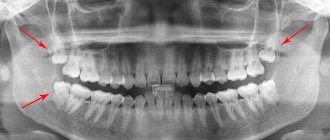Warts are classified as benign neoplasms.
They can appear on various parts of the skin and mucous membranes.
If a wart appears on the lip, it represents a cosmetic defect and can also cause discomfort to its owner, worsening the quality of life.
Forming on the lip, the tumor affects speech and interferes with eating.
A wart can cause pain, especially if it is localized on the mucous membrane inside the lip.
If measures are not taken to eliminate it, the growth may become injured, which will lead to a secondary infection.
Types of warts
A wart is a growth that rises above the surface of the skin or mucous membrane.
Its dimensions, as a rule, are no more than 1 centimeter in diameter.
The tumor can appear on any part of the body, including the face.
On the face, most often a wart forms on the lip, above or below the lip, on the buccal surface of the oral mucosa.
A warty growth can appear on both the upper and lower lips.
The following types of neoplasms are distinguished:
- Common (vulgar) warts. These are growths that have a dense structure, soft to the touch, flesh-colored or yellowish in color. New growths form on the red border of the lips. They are not painful, but tend to itch. Vulgar warts appear on the lips not only in adults, but also in children.
- Flat- shaped growths may appear on the outside of the lips or on the oral mucosa. Their surface is smooth, oval or round in shape. The color of the growth resembles the color of the skin and almost does not rise above it. The location is also the red border of the lips. Flat warts do not hurt, but they are very itchy.
- Hanging neoplasms are located on a thin stalk. At the beginning of development they resemble a bump. They have a brown, pinkish tint or close to the color of the skin.
- Filiform (acrochords). These are small growths that appear after 35 years, but can occur earlier.
- Genital warts . The localization of such growths is the mucous membrane. The new growths are elongated and arranged in groups, resembling a cockscomb or cauliflower inflorescences. The growths are prone to injury, which causes inflammation and bleeding.
The wart forms gradually and almost imperceptibly.
- At the beginning of development, a small compaction forms, which gradually increases.
- A white dot forms on the surface of the mucous membrane of the lip or in the mouth, which gradually turns into genital warts.
To date, approximately one hundred types of papillomavirus have been discovered.
Some types of growths have a benign course, while others are capable of malignancy.
They can provoke the development of cancer.
In addition to the types of growths listed above, there are also senile warts (keratoma, keratosis).
The difference between keratosis is that its appearance is not associated with papillomavirus, and keratoma does not provoke the formation of cancer.
In their development, senile warts go through several stages:
- ✓ brown spots appear, but the wart has not yet formed
- ✓ formation of papules and nodules
- ✓ appearance of keratoma - when you try to scrape off the scales, bleeding appears
- ✓ transition to the cutaneous horn, which is characterized by excessive growth and keratinization of the neoplasm
According to some experts, keratosis and senile warts belong to different diseases.
Intraductal papilloma (ductal papilloma).
Removal of papilloma on the nipple
Ductal papilloma (intraductal papilloma) occurs near the nipple; removal of papilloma on the nipple is possible using electrocoagulation under local anesthesia. Signs of intraductal papilloma (or nipple papilloma) are the appearance of blood-stained or transparent discharge from one nipple. Ductal papilloma is often a precancerous condition. Treatment of papillomas on the nipple and intraductal papilloma is carried out by a mammologist-oncologist.
On the picture:
papillomas on the face
The human papillomavirus (HPV) is widespread throughout the world. HPV causes warts, papillomas, and genital warts. Different types of human papillomavirus (there are more than 100 of them) cause different diseases.
Genital warts are small skin-colored formations, their size ranges from 1 mm to several centimeters. Genital warts can form on the genitals, near the anus, on the face, even in the mouth, on the body, abdomen, in the groin area, and in the armpits. This is a viral disease. The causative agent of genital warts is the human papillomavirus (HPV).
In men, the glans penis and frenulum of the foreskin are most often affected. In women, damage by the human papillomavirus appears on the labia, clitoris, vagina, and cervix.
Genital warts can be localized around the anus.
From single ones, genital warts can grow into rashes that can spread, taking on the appearance of cauliflower. “High-risk” HPV types (16, 18, 31, 33 and 35) cause cervical dysplasia and can become malignant.
The difference between a wart and keratoses and cancer
Keratosis may be similar in appearance to melanoma (a type of skin cancer).
Melanoma can begin as a warty growth or as a seborrheic keratosis.
A dermatologist can distinguish them from cancer.
To exclude an oncological process, a biopsy is performed.
The peculiarity of seborrheic keratosis is that the formation is waxy, flat, and there is no pain when touched or at rest.
With cancer, a growth similar to a keratosis may change shape or color.
In this case, you will need to consult a specialist.
What are the stages of laser removal of papillomas?
Preparations for the laser removal procedure for papillomas must be taken with full responsibility. You should not sunbathe or go to a solarium at least two weeks before surgery. It is also better not to use household chemicals, go on a hypoallergenic diet and lead a healthy lifestyle. All this will help the skin cope with the procedure and survive the recovery process.
If papillomas are detected anywhere in the body, you must contact a specialist to find out the cause of the infection. Immunodeficiency is quite often the first sign of the appearance of tumors on the skin. Treatment begins after a conversation with a dermatologist and cosmetologist.
Since papillomas cells consist of 75 percent water, the laser action is based on the evaporation of liquid and the destruction of pathological cells. The fabric is cut off layer by layer until the growth is completely removed. Healthy areas near the tumor are not affected and remain unharmed.
Laser removal lasts no more than five minutes and occurs in the outpatient room. Let us consider in order what stages are performed during the procedure.
Stage 1.
The doctor
treats the skin with an antiseptic
.
Stage 2.
The doctor
administers pain relief
by injecting the patient with a syringe or applying a cream containing an anesthetic such as novocaine or lidocaine to the skin.
Stage 3.
The
pain relief will take effect
in three to five minutes. We must wait for this time.
Stage 4.
Everyone in the room wears
safety glasses
to prevent the laser beam from burning the retina.
Stage 5.
The doctor takes a laser and
treats the papilloma
around the entire perimeter. The burn remaining after removal is treated with fucorcin or any other antiseptic. It is better to apply a dry gauze pad and a bandage.
During the entire procedure, the patient has no pain at all
. The recovery period for healing of the skin or mucous membrane takes from six to eight days.
Causes of warts
The appearance of warts is caused by infection with papillomavirus or HPV.
Since the skin on the lips is quite thin, it is therefore easily permeable to viruses.
It should be noted that signs of infection with the human papillomavirus do not always occur.
The better the immune system, the less likely it is that symptoms of the disease will appear.
And yet, most of the world's population is infected with HPV.
The incubation period for the development of the disease can be several months or years.
As soon as the immune system fails, the first signs of infection appear.
Activation of the virus is accompanied by the formation of warts.
As a rule, growths appear on the area of the skin or mucous membrane where the pathogen entered the body.
Infection can occur both through sexual contact and through household contact.
Can the virus be transmitted by kissing on the lips?
The most common cases of infection are:
- intrauterine infection of the fetus if a pregnant woman is infected with papillomavirus
- shaking hands or kissing an infected person (if there are wounds or abrasions, the risk of infection increases)
- the use of personal items of an infected person (toothbrush, dishes, lipstick) is unlikely, since the pathogen is not stable in the environment
- sex accompanied by oral sex
- visiting common areas (swimming pool, sauna, shower)
People at risk are those who:
- patients with diabetes mellitus or other pathology of the endocrine system
- suffer from obesity and metabolic disorders
- taking antibiotics for a long time
- have chronic diseases
- suffer from increased sweating, especially on the feet, as this is where plantar warts often form
A malfunction of the immune system can occur for the following reasons:
- If there is a deficiency of essential substances in the body
- After suffering stress or physical exhaustion
- In case of hormone imbalance: during puberty, during pregnancy, with the onset of menopause, during treatment with hormonal drugs
- In case of chronic lack of sleep and overwork
- Due to a recent infectious disease
- If a person abuses smoking and alcoholic beverages
Symptoms of the disease
Small tumors usually do not manifest themselves in any way. Medium and large papillomas cause discomfort. They interfere with normal air circulation, causing difficulty breathing. In the presence of such neoplasms, a person’s voice undergoes changes: it becomes nasal, hoarse, and speech is impaired. There are problems with swallowing food. The patient has a sensation of a foreign body in the throat. Large formations lead to a severe cough, and blood clots are observed in the sputum. In especially severe cases, the patient is diagnosed with airway obstruction and asthma attacks.
If the place of origin of neoplasms is the pharynx, they can most often be observed on the palatine tonsils and palatine arches. The most dangerous growths are in the larynx, since they are located next to the respiratory tract.
As we can see, the presence of such neoplasms causes severe discomfort to the patient, so if signs of the disease appear, you should contact an ENT doctor to diagnose the disease and have the papilloma professionally removed.
| Cost of admission | price, rub. |
| Initial visit (Payment is required upon initial visit) | 2000 |
| Repeated appointment | 1500 |
| Initial consultation with the head of the clinic (Payment is required upon initial visit) | 4000 |
| Repeated consultation with the head of the clinic | 2000 |
| Additional consultation during procedures | 500 |
| Adaptation of a child to the ENT office | 2000 |
| Adaptation of a child to the ENT office by the head of the clinic | 4000 |
| ENT diagnostics (carried out on the recommendation of an ENT doctor) | price, rub. |
| Endoscopy of the pharynx and larynx | 2500 |
| Videoendoscopy of the pharynx and larynx | 3000 |
| ENT manipulations | price, rub. |
| Application anesthesia | 500 |
| Infiltration anesthesia (local, injection, one injection) | 500 |
| Removal of pharyngeal papilloma | 5000 |
| Lubricating the back of the throat with medicinal solutions | 500 |
| Irrigation of the posterior pharyngeal wall using an ENT combine | 500 |
| ENT clinic discount | — 2000* |
| Cost of one day of treatment including discount | 5000 |
| Additional manipulations (carried out on the recommendation of an ENT doctor) | price, rub. |
| Session of infrared laser therapy of the posterior wall of the pharynx and palatine tonsils using the RIKTA device | 200 |
| Ultraviolet irradiation session of the posterior wall of the pharynx and palatine tonsils with the OUFd-01 Solnyshko irradiator | 200 |
| Ultrasonic medicinal irrigation session of the posterior pharyngeal wall and palatine tonsils using the TONSILLOR device | 1000 |
| Medicinal irrigation of the larynx using an ENT combine ATMOS 61 | 500 |
| Session of photodynamic therapy of the larynx and pharynx | 1000 |
| Percutaneous infrared laser treatment using the RVB device (Italy) | 200 |
* - discount is provided for complex treatment of the disease
Diagnosis of warts
The main diagnostic method is to examine the patient's face for the presence of warts on the lips and oral mucosa.
To confirm or refute the presence of HPV, it is enough to take tests:
- ✓ Blood tests for antibodies
- ✓ To conduct a histological examination (biopsy), a small part of the tumor is taken for analysis
- ✓ The PCR technique allows you to detect the genetic material of a pathogen with one hundred percent probability
Before getting rid of the growth, you should visit an oncologist.
A specialist will use dermatoscopy to determine the condition of the wart to rule out signs of malignancy.
Treatment results
The photo below shows the results of removal of neck papillomas using radio wave surgery
Rarely occur again. Reappearance of papillomas is possible with high virus activity in the body. In this situation, additional treatment with immunomodulators or consultation with an immunologist may be required.
Clinical manifestations of warts on the lip
A wart on the lip does not appear the next day after the papilloma virus enters the body.
The incubation period can last from six months to several years.
This often occurs when the immune system malfunctions.
Having penetrated the skin or mucous membrane, the virus integrates its genetic material into human cells and thus begins to multiply.
As a result, characteristic neoplasms appear at the site of virus introduction.
The pathogen provokes warty growths, disrupting the processes of keratinization of the skin.
Oncogenic strains of papillomavirus change the genetic apparatus of cells in such a way that a malignant formation is formed.
Laser removal of papillomas and other methods of elimination
It is recommended to begin treatment for HPV immediately after an accurate diagnosis and consultation with a doctor. It is necessary to fight the virus in full. An integrated approach includes the selection of the correct therapy to eradicate the causes of the disease and laser or any other removal of papillomas from the human body.
There are several variations of methods for eliminating growths. All of them are painless, safe and will not leave scars.
Medical removal of papillomas (cauterization)
This is removal with the help of drugs -
such as natural compounds feresol or verrucacid containing phenol and metacresol. These drugs are used to cauterize papilloma. This procedure must be performed with extreme precision and caution. You can't do it yourself. Carelessness and lack of experience often lead to burns.
Laser removal of papillomas
Laser removal of papillomas and condylomas involves a burning process using a carbon dioxide laser beam
. The laser hits exactly the right place and does not damage the surrounding skin. As a result of removal, a microscopic wound is left that heals in three to four weeks. The skin heals itself, so additional restorative procedures are not necessary. Scars will not appear. Laser removal of warts and papillomas is not recommended if there are wounds or any inflammation on the skin, herpes or other infection. This procedure is also not performed during pregnancy. Laser removal of papillomas located on the face, eyelids, and armpits is carried out if both single and multiple neoplasms are detected.
Removal of papillomas with liquid nitrogen (cryodestruction)
The method involves short-term exposure of the papilloma to very low temperatures.
. The damaged area of skin is treated with liquid nitrogen, after which it loses sensitivity and becomes white. Freezing occurs immediately, as a result of which the papilloma is destroyed. Tissue healing may take five to six weeks. There will be no scars left. This procedure has a number of advantages. It is well tolerated by humans, painless and does not require pain relief.
Radio wave removal of papillomas
Radio wave removal is the optimal solution for skin problems. It occurs using the Surgitron device. The neoplasm is destroyed due to energy that heats the papilloma from the inside without damaging surrounding tissues
. The electrode, which is the main working part of the device, heats up, and the papilloma is immediately “cut off” with one movement. In this case, there is no loss of blood due to the fact that the tissues are cauterized and remain unharmed, and the vessels are “sealed”. The procedure does not cause pain. After it, the wound heals quickly and no traces of papilloma removal remain.
Electrocoagulation
With electrocoagulation, the destruction of pathological tissue is achieved by exposing it to electric current.
using EHF devices. High temperature affects the papillomas, and they are destroyed. The advantage of this procedure is the ability to control the depth of exposure, as well as its low cost. But there are several disadvantages. Nearby tissues and skin areas may be subject to injury. Healing after this method occurs over a long period.
Surgical removal with a scalpel
Surgical removal is used in cases of removal of large tumors
. The operation is performed under local anesthesia. Since after removal, cosmetic stitches are applied to the skin for seven days, this method is used extremely rarely if the papillomas are on the face. But it is effective in the fight against malignant growths.
ethnoscience
Traditional medicine has always helped to get rid of any misfortune. To remove papillomas, the method of treating them with celandine juice
.
This plant has poisonous juice, therefore, in order not to damage neighboring areas, baby cream is applied to them. A drop of celandine juice is squeezed onto the neoplasm itself. The next option is an infusion of dandelions in alcohol
, which is applied to the area of the growth five times a day.
The infusion is prepared in the following way. The heads of dandelion flowers are placed in a glass jar and filled with ethyl alcohol. It should be kept in a dark room for two weeks. And then use it for treatment. It is difficult to say how safe and effective all of these methods are, so it is better not to tempt fate and consult a doctor
.
Read material on the topic: Dermatological facial cleansing: types, reviews and prices
Is it necessary to remove a wart on the lip?
Removal of the tumor is carried out if there are indications for this.
The growths sometimes disappear spontaneously.
Therefore, if the wart is small and does not cause much concern, then there is no need for removal.
The decision to excise the growth must be made by a specialist.
If a wart causes discomfort in the form of itching, burning, pain, grows, becomes inflamed, or changes in appearance.
If it has increased in size, changed shape and color, or is bleeding, then it must be removed by resorting to excision by one of the methods.
Removing a tumor at home is not safe.
As a result of incorrect actions:
- It may not be possible to remove the wart completely, which will cause its reappearance
- the risk of injury to healthy tissues that surround the growth increases
- scars and cicatrices may form
How is the papillomas removal procedure performed?
Laser is most often used to remove papillomas; it is excellent for work if you need to remove many small papillomas. If you need to remove papillomas larger than 5 mm, we recommend the radio wave method. The methods are absolutely safe, do not injure deep skin tissues and leave no cosmetic defects such as scars. Laser and radio wave methods also have some advantages compared to other methods:
- There is no bleeding because the vessels are instantly cauterized;
- Thanks to coagulation of the bed where the papilloma was located, the risk of infection is reduced;
- Fast healing and short rehabilitation period;
- The risk of recurrence of papilloma is close to zero.
Taking into account the test results and visual examination, an experienced specialist will individually select an effective and safe method for removing papillomas.
Prices for removal of papillomas on the face
How many procedures do you need to undergo to remove papillomas on the face?
Removal of papillomas on the face occurs in just one procedure, however, in case of multiple formations, a repeat visit may be necessary. During the procedure, up to 20-30 papillomas can be removed, and in some cases more.
In the postoperative period, caring for the bed of a removed papilloma is not much different from the same manipulation with moles.
Wart treatment
Treatment of any growth on the lips begins with a medical examination and determining whether the growth is malignant.
Next, the doctor selects a method of therapy.
In case of a malignant form, the patient is referred to an oncologist, who will decide how to treat the patient.
Treatment of the disease is complex.
Treatment consists of the main stages: removal of the growth and drug therapy.
Removal of the tumor can be done in one of the following ways:
- ✓ Using pharmaceutical products
- ✓ In a medical institution where modern excision techniques will be used
- ✓ Folk remedies. The use of alternative medicine methods must be agreed with a doctor
In what cases should laser removal of papillomas not be used?
Contraindications
for laser removal of warts and papillomas are:
- Herpes in the acute stage;
- Diabetes;
- Pregnancy and lactation;
- Epilepsy;
- Immunodeficiency conditions;
- Malignant nature of neoplasms;
- Any diseases of the skin and blood;
- Tan obtained 2 weeks (or less) before the procedure.
Pharmacy products for removing warts
You can buy medications at the pharmacy that will help you deal with warts at home.
Among them:
- Super clean . The product is an alkaline solution that has a chemical effect on the growth, causing cauterization.
- Cryopharma, Wartner . These agents cause cryodestruction of the wart; as a result of cold exposure, the neoplasm is frozen.
- Solcoderm . A drug containing acids that have a cauterizing and mummifying effect on pathological tissues.
- Immunomodulators – Viferon, Oxolinic ointment will help increase immunity and the body’s fight against the virus.
- Antiviral agents – Isoprinosine, Interferon.
The use of cauterizing agents on the lips and face is extremely undesirable; application of these agents to the oral mucosa is especially dangerous.
Types of growths for which the laser method of removing papillomas is used
Let's look at the main types of papillomas.
- Simple
- hard nodules covered by keratinized skin. They can appear close to each other and merge into one large formation.
- Flat
- look like moles.
- Thread-like –
bump-like growths resembling a mole. Subsequently, they spread and turn into papillary-like formations up to 6 mm in size. Appear on the skin in the eye area, neck, armpits.
- Plantar –
cones with a smooth surface, surrounded by a rim.
- Genital
warts
are growths that appear on the mucous membranes of the genital organs. This species is spread through sexual contact. - Epithelial
hyperplasia
is a small growth that affects the lips and mouth. They can merge with each other. - Juvenile
laryngeal
papillomas - they are found in the larynx of newborn children. Infection occurs from the mother when passing through the birth canal.
Read material on the topic: Lightening age spots
Wart removal in the clinic
The clinic uses modern hardware techniques to excise growths:
- Laser therapy . The method allows you to quickly and without blood remove the growth. There is no discomfort during the procedure, as pain relief is performed. During one session, you can get rid of several tumors in a very short time. The method is suitable not only for adults, but also for children. The likelihood of relapse is minimized. Skin defects in the form of scars after laser use are very rare.
- Radio wave therapy . The technique is considered the safest. When excising a wart using a radio wave, there is no contact with the skin. It is not always possible to completely remove the growth. The procedure leaves no traces of impact.
- Electrocoagulation . The procedure requires anesthesia. Using an electrode to which a high-frequency electric current is applied, the wart is burned out, followed by cutting off the growth with a special metal loop. Scarring may appear after removal.
- Cryodestruction . Liquid nitrogen is used and the wart is treated until it turns white. As a result of exposure to low temperatures, the growth tissues die. There is no need for anesthesia for the manipulation. The disadvantage of the technique is the lack of control over the depth of nitrogen exposure. For this reason, frequent relapses occur.
- Surgical. Removal is done using a scalpel. The disadvantage of the procedure is the formation of a scar, so this technique is used only for certain indications (in case of malignancy of the process and large size of the wart).
Advantages of treating human papillomavirus at Deltaclinic
- Our clinic has all the necessary specialists (dermatologist, dermatologist-oncologist, proctologist, urologist, gynecologist) who remove condylomas and papillomas of any location.
- The most modern equipment (lasers, electrocoagulation, radio wave), which allows you to get rid of condylomas on the day of the visit.
- Condylomas are removed without leaving a trace. Excellent cosmetic effect - no trace remains on the skin and mucous membranes.
- Fast healing time.
- An accurate diagnosis of the type of papillomavirus is carried out. General immunostimulating and antiviral therapy is prescribed.
- Removal of candylomas is carried out on an outpatient basis; hospitalization is not required.
Photo:
Surgitron device for non-surgical (radio wave) removal of condylomas.
Do not delay your visit to the doctor, genital warts must be removed! If papillomas are not removed, they can spread throughout the body. The virus can be transmitted to other people with whom an HPV-infected person comes into contact. A woman can infect her fetus during childbirth. Cases of familial infection with the human papillomavirus are common.










